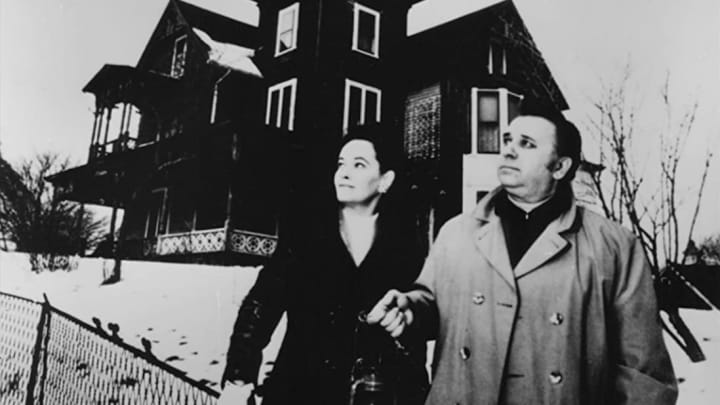When it comes to investigations of the paranormal kind, no two ghost hunters loom larger than Ed and Lorraine Warren. Over the course of 50 years, Ed, a demonologist, and Lorraine, a trance medium, looked into thousands of cases around the globe, and claimed to have encountered phenomena so scary that their exploits were often turned into films, including The Amityville Horror, The Conjuring movies, and The Haunting In Connecticut. But even if you're familiar with their most famous cases, there's probably still a lot you don't know about the Warrens.
1. Ed Warren grew up in a haunted house.

When Ed was 5, he claimed he saw an apparition: a dot of light that grew until it became his family's landlady, who had died the year before. In The Demonologist: The Extraordinary Career of Ed and Lorraine Warren, Ed recalled that she was "semi-transparent, wearing what looked like some sort of shroud ... then she vanished." Soon after, Ed was having dreams of dead relatives he’d never met, including an aunt who would send him messages about his future, telling him that he would help many priests but never become a priest himself. "I'm not a priest today, but I do work closely with them," he said in The Demonologist.
2. Lorraine Warren discovered her abilities when she was a child.
Like Ed, Lorraine began having unusual experiences when she was young, too—but she just assumed everyone had those same abilities. That all changed when she was 12. As she recalled in The Demonologist, it was Arbor Day at her all-girls' private school, and her classmates had just planted a sapling. "Just as soon as they put the sapling in the ground, I saw it as a fully grown tree ... filled with leaves blowing in the wind," she said. When a nun asked her why she was staring at the sky, Lorraine responded, "I told her I was just looking up into the tree ... 'Are you seeing the future?' she asked me, just as sternly. 'Yes,' I admitted, 'I guess I am.'"
3. Ed and Lorraine Warren began dating as teenagers.
Ed and Lorraine both lived in Connecticut and met in 1944, when they were both just 16 years old—Ed worked as an usher at a movie theater that Lorraine and her mother frequented. They began dating, and soon after, Ed went off to fight World War II.
4. Ed and Lorraine Warren got married in 1945, thanks to a sunken ship.
In 1945, when Ed was 17 years old, he enlisted in the Navy. He had only been deployed for a total of four months when he was sent back home on a 30-day "Survivor's Leave" after his ship went down in the North Atlantic Sea. It was during that short break that Ed and Lorraine got married, then he returned to war. The couple later had a daughter named Judy.
5. The Warrens thought they'd make their livings as artists.

After the war, the Warrens had to figure out how to make a living. "Each of us had skills as landscape artists, and we each harbored a desire to paint," Lorraine said. Ed had taken art classes, so, she said, "we began our marriage under the assumption that we were going to be artists."
Rather than painting landscapes, the Warrens decided on a more unusual subject on which to focus: haunted houses, which Ed found in the newspaper. They'd go to the houses, sketch them, then knock on the door and "offer [the sketch] for information about the haunting," Lorraine said. If the story was compelling enough, they'd actually paint the house and sell that artwork later. They spent about five years going around the United States, painting and investigating haunted houses.
6. Lorraine Warren was initially a skeptic.
Despite her early experiences with clairvoyance, Lorraine didn’t believe in ghosts until later in life, after she and Ed began visiting and painting haunted houses. "In the beginning, I was more than a bit wary of the people with whom we spoke," she said in The Demonologist. "I thought they were kind of suffering from overactive imaginations or were just making things up to get attention." But when she noticed the similarities between the experiences—including from people who had never met, and who were from opposite sides of the country—she became a believer.
7. Ed and Lorraine Warren founded the New England Society for Psychic Research in 1952.
The Warrens founded the New England Society for Psychic Research to document their cases, and they also created The Occult Museum—a space in their Monroe, Connecticut, home, which adjoined Ed's office—to house haunted objects and the files and tapes from their investigations. Today, the NESPR is run by the Warrens's daughter Judy and son-in-law, Tony Spera, and its website keeps a log of some of the cases the Warrens investigated, including that of an alleged werewolf and the infamous possessed doll, Annabelle.
8. Lorraine Warren had her abilities tested.

As the Warrens began taking on bigger and bigger cases, skepticism about the couple grew. To quiet critics, Lorraine agreed to be tested by Dr. Thelma Moss, an actress-turned-psychologist and parapsychologist (a researcher with an interest in the occult) working in a UCLA lab studying things like Kirlian photography. She found that Lorraine's clairvoyance was “far above average,” according to The Demonologist.
9. Ed and Lorraine Warren never charged money for their investigations.
Instead, they made a living from giving lectures at colleges, and by licensing the rights to their stories for film, TV, and book projects.
10. Ed and Lorraine Warren saw their main roles as educators.
The Warrens began giving lectures because, according to The Demonologist, there was a growing interest in the occult in the late 1960s, and many of the people they saw affected by dark phenomena were college students. They hoped that, through their lectures, they might discourage people from exploring the occult in the first place.
